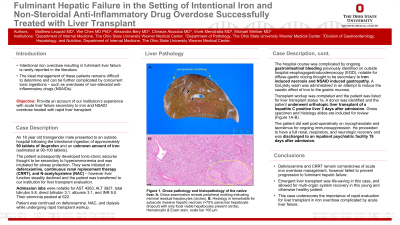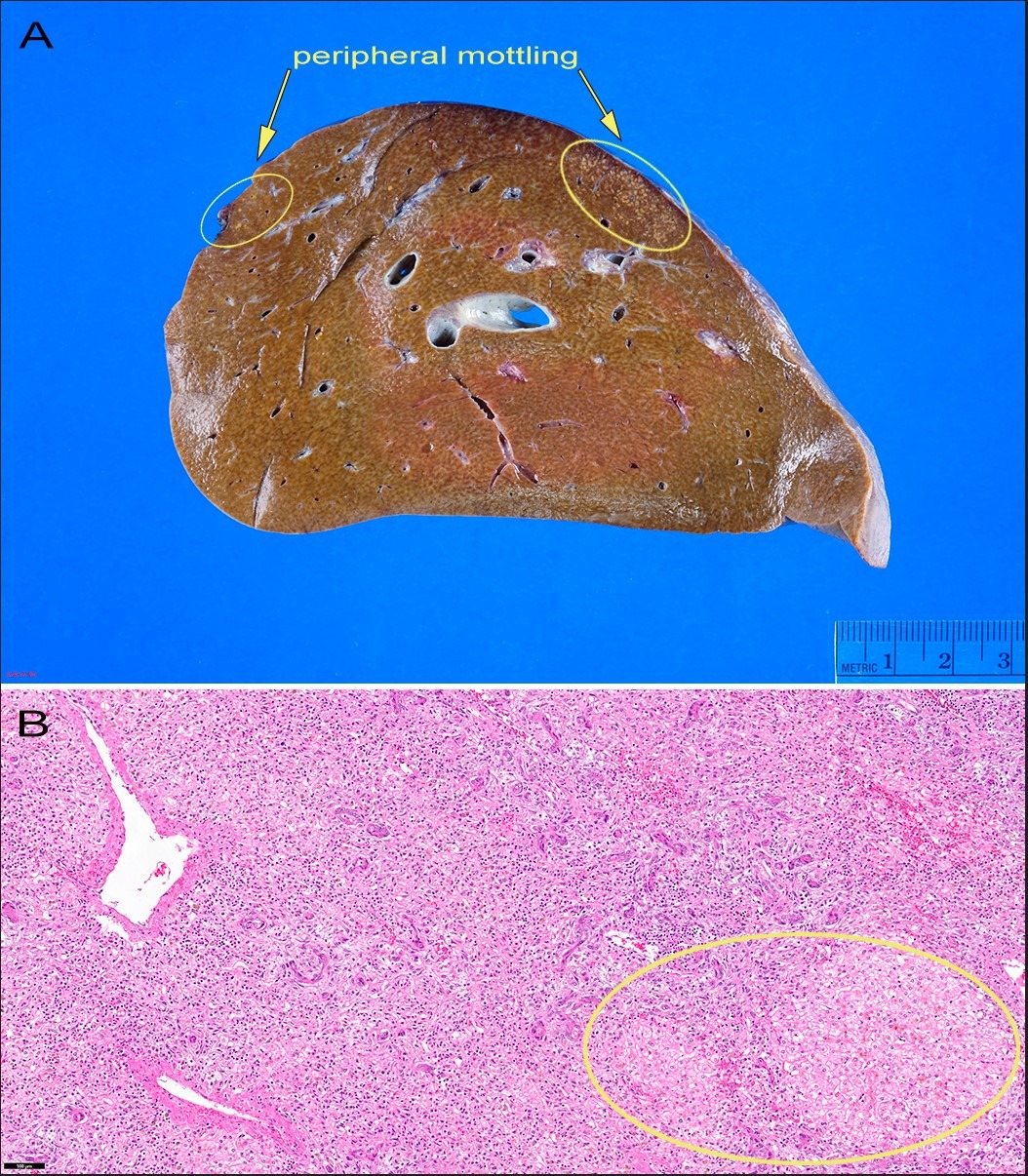Monday Poster Session
Category: Liver
P2523 - Fulminant Hepatic Failure in the Setting of Intentional Iron and Non-Steroidal Anti-Inflammatory Drug Overdose Successfully Treated with Liver Transplant
Monday, October 23, 2023
10:30 AM - 4:15 PM PT
Location: Exhibit Hall

Has Audio

Matt Leupold, MD
The Ohio State University Wexner Medical Center
Columbus, OH
Presenting Author(s)
Matt Leupold, MD1, Wei Chen, MD, PhD2, Alexandra Bery, MD1, Chineze Akusoba, MD3, Vivek Mendiratta, MD1, Michael Wellner, MD1
1The Ohio State University Wexner Medical Center, Columbus, OH; 2Ohio State University Wexner Medical Center, Columbus, OH; 3The Ohio State University, Columbus, OH
Introduction: Intentional iron overdose resulting in fulminant liver failure is rarely reported in the literature. Given this, the ideal management of these patients remains difficult to determine and can be further complicated by concurrent toxic ingestions – such as overdoses of non-steroidal anti-inflammatory drugs (NSAIDs). Our institutions experience with one such patient is outlined below.
Case Description/Methods: An 18 year old transgender male presented to an outside hospital following the intentional ingestion of approximately 90 tablets of ibuprofen and an unknown amount of iron (estimated at 90-100 tablets). The patient subsequently developed tonic-clonic seizure thought to be secondary to hyperammonemia and was intubated for airway protection. They were initiated on deferoxamine, continuous renal replacement therapy, and N-acetylcysteine (NAC) – however liver function steadily declined and the patient was transferred to our institution for liver transplant evaluation. Admission labs were notable for AST 4263, ALT 3927, total bilirubin 5.8, direct bilirubin 3.1, albumin 3.1, and INR 9.0. His ammonia peaked at 622. Patient was continued on deferoxamine, NAC, and dialysis while rapidly undergoing transplant workup. Hospital course was complicated by ongoing gastrointestinal bleeding previously identified on outside hospital esophagogastroduodenoscopy (EGD), notable for diffuse gastric oozing thought to be secondary to iron induced necrosis and NSAID induced gastropathy. Rapid transplant workup was completed and the patient was listed for liver transplant status 1a. A donor was identified and the patient underwent orthotopic liver transplant of a hepatitis C positive liver 3 days after admission. Gross specimen and histology slides are included for review (Figure A-B). The patient did well post-operatively on mycophenolate and tacrolimus for ongoing immunosuppression. He proceeded to have a full renal, respiratory, and neurologic recovery and was discharged to an inpatient psychiatric facility 19 days after admission.
Discussion: Deferoxamine and CRRT remain cornerstones of acute iron overdose management, however failed to prevent progression to fulminant hepatic failure. Emergent liver transplant was life-saving in this case, and allowed for multi-organ system recovery in this young and otherwise healthy patient. This case underscores the importance of rapid evaluation for liver transplant in iron overdose complicated by acute liver failure.

Disclosures:
Matt Leupold, MD1, Wei Chen, MD, PhD2, Alexandra Bery, MD1, Chineze Akusoba, MD3, Vivek Mendiratta, MD1, Michael Wellner, MD1. P2523 - Fulminant Hepatic Failure in the Setting of Intentional Iron and Non-Steroidal Anti-Inflammatory Drug Overdose Successfully Treated with Liver Transplant, ACG 2023 Annual Scientific Meeting Abstracts. Vancouver, BC, Canada: American College of Gastroenterology.
1The Ohio State University Wexner Medical Center, Columbus, OH; 2Ohio State University Wexner Medical Center, Columbus, OH; 3The Ohio State University, Columbus, OH
Introduction: Intentional iron overdose resulting in fulminant liver failure is rarely reported in the literature. Given this, the ideal management of these patients remains difficult to determine and can be further complicated by concurrent toxic ingestions – such as overdoses of non-steroidal anti-inflammatory drugs (NSAIDs). Our institutions experience with one such patient is outlined below.
Case Description/Methods: An 18 year old transgender male presented to an outside hospital following the intentional ingestion of approximately 90 tablets of ibuprofen and an unknown amount of iron (estimated at 90-100 tablets). The patient subsequently developed tonic-clonic seizure thought to be secondary to hyperammonemia and was intubated for airway protection. They were initiated on deferoxamine, continuous renal replacement therapy, and N-acetylcysteine (NAC) – however liver function steadily declined and the patient was transferred to our institution for liver transplant evaluation. Admission labs were notable for AST 4263, ALT 3927, total bilirubin 5.8, direct bilirubin 3.1, albumin 3.1, and INR 9.0. His ammonia peaked at 622. Patient was continued on deferoxamine, NAC, and dialysis while rapidly undergoing transplant workup. Hospital course was complicated by ongoing gastrointestinal bleeding previously identified on outside hospital esophagogastroduodenoscopy (EGD), notable for diffuse gastric oozing thought to be secondary to iron induced necrosis and NSAID induced gastropathy. Rapid transplant workup was completed and the patient was listed for liver transplant status 1a. A donor was identified and the patient underwent orthotopic liver transplant of a hepatitis C positive liver 3 days after admission. Gross specimen and histology slides are included for review (Figure A-B). The patient did well post-operatively on mycophenolate and tacrolimus for ongoing immunosuppression. He proceeded to have a full renal, respiratory, and neurologic recovery and was discharged to an inpatient psychiatric facility 19 days after admission.
Discussion: Deferoxamine and CRRT remain cornerstones of acute iron overdose management, however failed to prevent progression to fulminant hepatic failure. Emergent liver transplant was life-saving in this case, and allowed for multi-organ system recovery in this young and otherwise healthy patient. This case underscores the importance of rapid evaluation for liver transplant in iron overdose complicated by acute liver failure.

Figure: Figure A, Gross examination reveals peripheral mottling indicating minimal residual hepatocytes (circles). Figure B, Histology is remarkable for subacute massive hepatic necrosis (>75% panacinar hepatocyte dropout) with only focal viable hepatocytes present (circle), Hematoxylin & Eosin stain, scale bar 100 µm.
Disclosures:
Matt Leupold indicated no relevant financial relationships.
Wei Chen indicated no relevant financial relationships.
Alexandra Bery indicated no relevant financial relationships.
Chineze Akusoba indicated no relevant financial relationships.
Vivek Mendiratta indicated no relevant financial relationships.
Michael Wellner indicated no relevant financial relationships.
Matt Leupold, MD1, Wei Chen, MD, PhD2, Alexandra Bery, MD1, Chineze Akusoba, MD3, Vivek Mendiratta, MD1, Michael Wellner, MD1. P2523 - Fulminant Hepatic Failure in the Setting of Intentional Iron and Non-Steroidal Anti-Inflammatory Drug Overdose Successfully Treated with Liver Transplant, ACG 2023 Annual Scientific Meeting Abstracts. Vancouver, BC, Canada: American College of Gastroenterology.
